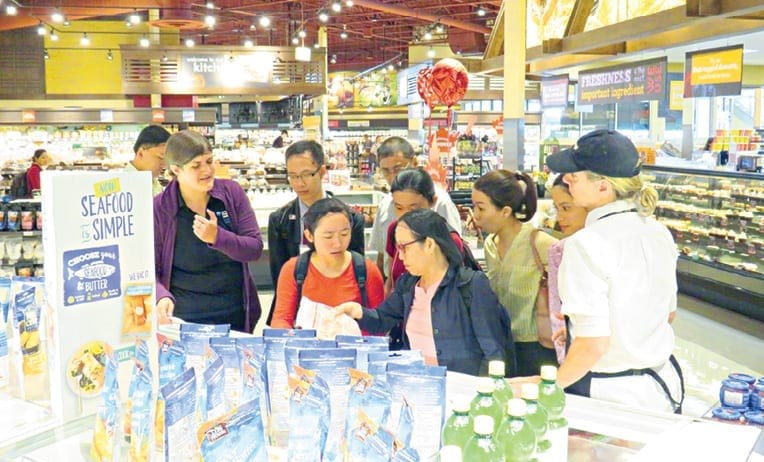Food professionals tour Sobeys, find shrimp from home
BY SAMUEL PICCOLO The VOICE
However pleasant a person Ron Kore is (he is, after all, reigning Citizen of the Year), and however nice his Fonthill Sobeys store may be, 14,000 kilometres is a long way to go for groceries.
Local shoppers certainly seemed bemused to find a dozen Vietnamese nationals wearing hairnets assembled outside the main entrance last Tuesday. The group’s expressed intention was not to shop, however—they were about to be led through the building’s inner sanctum as part of a two-week study stay at Niagara College on the Canadian food industry.
All 12 of the participants were from the Faculty of Food Science at Vinh Long Community College, about 150 kilometres outside Ho Chi Minh City. Vinh Long has a partnership with Niagara College, and its instructors were in Canada to become familiar with the requirements of retailers here, with the idea that they will be better able to teach Vietnamese food companies how to prepare their products for the Canadian market.
Along with several Sobeys employees, Niagara College’s Amy Proulx led the contingency around the store, explaining the importance of meeting Canadian standards as she went.
“Understanding your retailer is so vital to understanding how you can help the food companies that you serve come up with an idea and turn it into a product that’s sold…There are questions you have to ask. Is it GFSI- certified? Is it compliant with its labelling?” she said, dropping industry terms and acronyms that the interpreter seemed to have no trouble translating.
With a few straggling behind, the group was soon taken through the swinging doors near the dairy department.
They watched as boxes from a refrigerated truck were stacked, checked off a list, and carted away for shelving. Proulx made special note of Canada’s “chained” food system, in which attention is paid to food at every stage from production to retail. She pointed out the eyewash station (which was collecting dust—Kore could put a sign out front reading, “5,000 days without an eye injury”), the chemical room, and later, to her obvious joy, the presence of three sinks.
“Wash, rinse, sanitize,” she said proudly.
Proulx has been closely involved with the educational part of this visit, and she had visited Vinh Long to begin the partnership. Niagara College is working with the Department of Global Affairs, which funded the project. The Canadian government has made educating foreign industries of our domestic standards a priority, all in an effort to increase trade.
Just as the government is looking abroad, so too is the college. Jorge Blandon, from its International Projects department, said that there are similar projects ongoing with schools in Peru, Bolivia, and Jamaica.
The Canadian government and Niagara College have evidently made a strategic investment in such programs, hoping to see future returns, but last week it was the visitors enjoying themselves for the time being. Hoàng Nô, who has taught at Vinh Long for 15 years, was thrilled with the experience so far.
“The biggest thing I’ve learned is the importance of connectivity—of making sure that everything is perfect at every step of the way,” he said, adding that he was looking forward to better serving the industry back home with what he’d gleaned in his stay in Canada.
Proulx acknowledged that efforts to augment international food trade are at odds with the encouragement to eat more locally, but argued that Canada’s diversity means that one approach to sourcing food is inadequate.
“Many first and second generation immigrants like to gravitate to their culinary traditions, and that means finding foods that meet those traditions,” she said, gesturing to the seafood section, where earlier the visitors had delighted in seeing Vietnamese shrimp.
Once the group had left the enclosed processing area and moved out into the open, it was harder to keep them together.
A few wandered over to the bakery, peering at the frosted cakes glistening behind glass. Proulx marched on, speaking to her diminished class in the meat section. She explained that, along with dairy and fish, it was the most regulated product in Canada.
The crowd was almost gone by now, and even the interpreter was distracted by something on offer. Proulx pretended not to notice at first, but at last she gave up and looked over to the deli counter where Nô and several others had congregated. They were pulling at their wallets and gesturing to the attendant, trying to explain that they had come from halfway across the world, and they wanted to buy some kielbasa.



